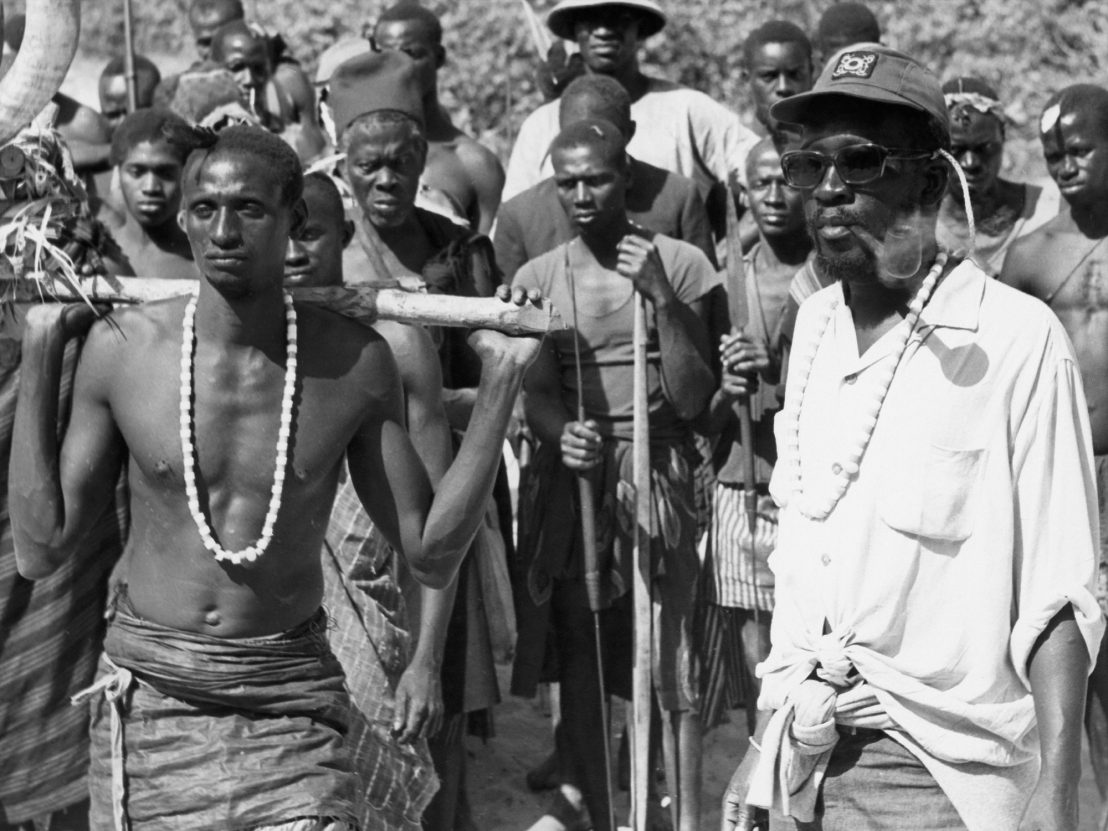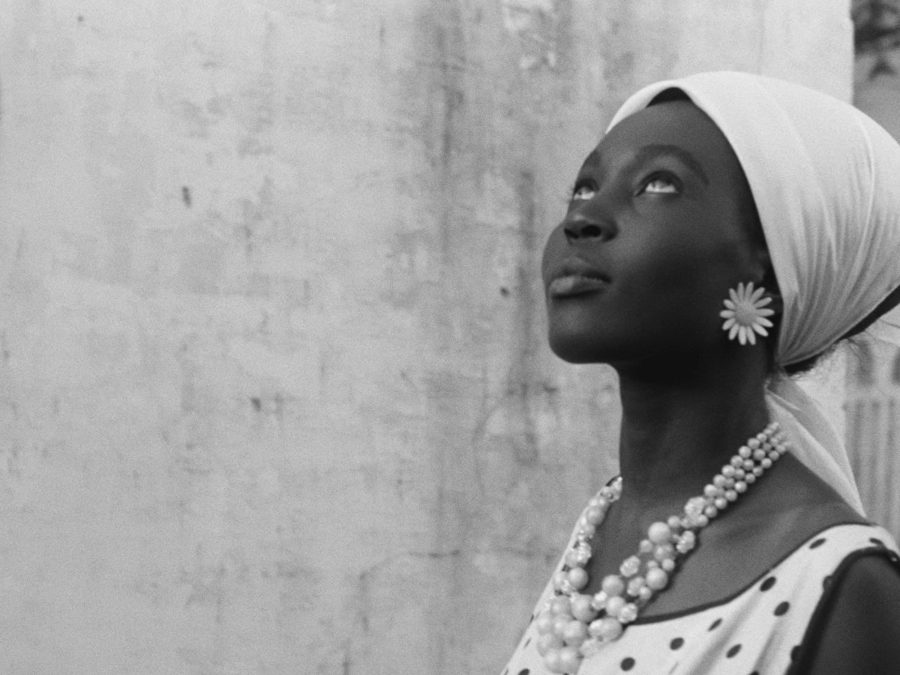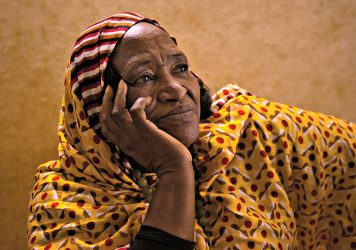
Some directors make films to be artists. Others, to be entertainers. Ousmane Sembène saw film as the most effective tool for political activism. “Of all the arts”, he said, “it’s the form of expression that’s most accessible and appealing to a large audience”.
In honour of the centenary of his birth, the BFI are celebrating ‘the father of African cinema’ with a new season: Rebel Cinema: Ousmane Sembène at 100. Before his death in 2007, Sembène produced a diverse body of work: he was a satirist, a humanist, but above all, he was an activist. It’s not that his films aren’t entertaining or artistic; they are expertly crafted and were widely popular. Rather, their value as art and entertainment lies in their ability to alert viewers to the entrenchment of colonialism and their suggestions for alternative futures.
Born in Senegal in 1923, Sembène worked a series of manual jobs as a young man. His military service with the French during World War Two and his working-class upbringing shaped his later artistic output: grounded in realism and attuned to the political reality of ordinary people.
In 1961, after publishing several novels, Sembène spent a year studying film at the Gorky Film Studio in Moscow. He wanted his films to awaken consciousness in ordinary Africans, to decolonise their thinking in order to create a new Africa free from the corrupting influence of Europe. Sembène famously referred to cinema as a ‘night school’ for the masses, a way to speak to a public with high levels of illiteracy in a medium that was more accessible than literature.
That wasn’t an easy task. Despite Senegal having formally gained independence in 1960, France continued to exert major influence over the country, including its film financing and distribution. Unsurprisingly, Sembène ran into difficulties making films that tackled neocolonialism head-on.
This was certainly the case for his first feature film, La Noire de… (Black Girl, 1963). The film tells the story of Diouana, a young Senegalese woman who moves from Dakar to Antibes to work as a maid for a bourgeois French couple. There she endures racism, alienation and dehumanisation; a sharp contrast to her life in Senegal. “I’m their prisoner,” Diouana realises. “I don’t know anyone here. No one in my family is here. That’s why I’m their slave.” Eventually she kills herself.
As with all of Sembène’s films, La Noire de … is more than the story of its protagonist. Diouana’s plight represents France’s continued grip on Senegal, as well as the Senegalese bourgeoisie who permit such exploitation. Sembène knew that the story of an exploited individual was the best way to tell the story of an exploited nation.
Women play a central role throughout Sembène’s work, and he argued that “the development of Africa will not happen without the effective participation of women. Our forefathers’ image of women must be buried once and for all.” Sembène paid attention to the condition of women throughout his career; even up until his final film, Mooladdé (2004), which offers a stark condemnation of female genital mutilation.
In 1971, he made Emitaï, portraying a revolt during the Second World War where village women under French rule refused to give up grain to the authorities. Through this film, Sembène acknowledges women’s essential role in colonial resistance and wider political struggles. Sembène’s desire was not to bring about an idealised pre-colonial Africa, but instead to realise a future where both men and women could contribute to the development of the continent beyond colonialism.

The very fact that Sembène was able to make the radical films that he did is testament to his effectiveness as an activist. The French Ministry of Cooperation provided financial and technical support to African filmmakers in former colonies, but, as Sembène himself found out, assistance was often tied to promoting French values. Sembène’s script for La Noire de … was rejected for financial aid, with the Cooperation buying the rights only once Sembène had independently produced the film.
It wasn’t the last run-in Sembène had with the system of French financing. For his 1968 film Mandabi, he received funding from the French Centre National Du Cinéma, but with a condition they hire a producer for him, Robert Nesle.
Nesle tried to influence the artistic vision of the film. Despite Sembene’s objections, Nesle insisted the film be shot in colour. Another condition stipulated the film had to be in French, resulting in Sembène effectively shooting Mandabi twice: once in Wolof and then again in French. In the end, the French version was never screened, and Mandabi became the first African film to be shot in an African language.
Sembène successfully resisted other requests, such as Nesle’s insistence for sexual scenes to be included in the film, but only after Sembène stopped production and took the matter to court.
It wasn’t just Semebène’s artistic sensibility that was being threatened; to interfere with his films was to distort his vision of a decolonised Africa. As Sembène put it, co-production with the West was “tainted with paternalism” and amounted to “an economic dependency which, as such, gives the West the right to view Africa in a way that I cannot bear.”
However, Sembène’s films didn’t just confront Europeans. For Sembène, Africans who upheld European values for their own financial gain stunted a country’s development just as much as colonial powers. By the 1970s – as relayed to Harold D. Weaver in an interview for Cineaste – he wanted to make a film about “the birth of the black bourgeoisie”. The result was Xala (1974), based on his own novel from the year before.
Xala (the Wolof word for impotence) tells the story of El Hadji, a businessman who finds himself unable to consummate his third marriage on his wedding night. As with his other films, the central story stands for something larger: the impotence at the heart of the film represents the impotence of the Senegalese bourgeoisie; they fail to produce anything meaningful for Senegalese society.
Though the film opens with the Europeans being ousted from the local chamber of commerce, Xala clearly shows Europe continuing to hold its grip over Senegal. In doing so, Sembène condemns both the former colonial powers and the new bourgeoisie who help perpetuate this power. The Senegalese businessmen wear Western suits, drink imported Evian and drive luxury Mercedes. (According to Sembène, nobody drove a Mercedes around Dakar for three months following the film’s release.)
In a cruel irony for a film that tackles France’s colonial legacy, Xala was not allowed to be released in Senegal without cuts. Sembène conceded but distributed flyers that explained the lost scenes to the Senegalese public.
Eventually, Sembène stopped seeking support from the French. He did not want to see an African cinema dependent on aid from former colonial powers. In this way, Sembène married form and content to create a truly political cinema.
Sembène knew that his responsibility as a filmmaker did not end with the film: he engaged with his audiences, debating them on the future of the continent. Watching his films in the 21st century, we should acknowledge the continued legacy of colonialism. But we should also remember the idea that filmmakers can aspire to a cinema beyond entertainment or high art. In a world beset with problems, we should follow Sembène’s example and embrace cinema’s potential to honour the powerless and challenge the powerful.
Published 16 Aug 2023

By Leila Latif
A new restoration of his long out-of-print 1968 film Mandabi offers cause to celebrate the late Senegalese maverick.

By Helen Reid
Four titles playing at Film Africa in London showcase African filmmakers finally telling their own stories.

This year’s Film Africa event showed that African people are still not free to define their own identity abroad.